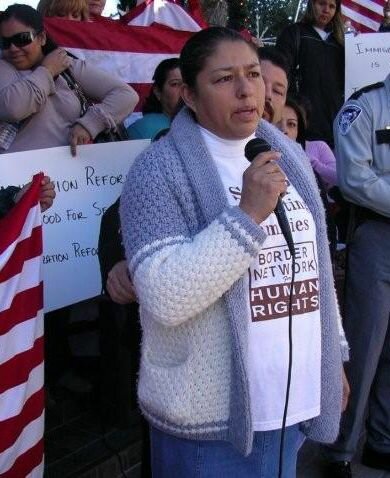The Border Network for Human Rights: Building an immigrant movement in the besieged borderlands
Organizing Latino Immigrants for Social Justice — By Guest Author on May 10, 2010 at 06:00By Josiah Heyman, Professor of Anthropology, University of Texas at El Paso
The Border Network for Human Rights (BNHR) is an immigrant community based organization working for human rights in the El Paso and southern New Mexico area of the U.S.-Mexico borderlands. It consists of a small central staff and a large set of local committees that define goals and issues, and participate in key activities. The communities’ chosen focus is on rights and dignity when subject to immigration law enforcement. This offers us two lessons: that relevant issues include the conduct of enforcement as well as legalization and comprehensive immigration reform; and the importance of base organizing over long periods of time prior to moments of activism and mobilization.
The BNHR began in 1999, as a successor organization to the Border Rights Coalition, a small (but sporadically effective) coalition of mostly educated, non-immigrant activists, focused on public events and policies. The BNHR shifted its approach toward base organizing within immigrant communities themselves. The first approach was by (initially volunteer) human rights promoters who came themselves from those communities, trained in human and constitutional rights by the BNHR Director, Fernando Garcia. Eventually, using a train the trainer methodology, the number and thus reach of human rights promoters grew. The committees became self-perpetuating organizations, meeting on a weekly basis (as one member described, “like attending church”), where they would discuss two main themes: policy priorities and applications of human rights themes to actual community experiences.
The committees have gradually multiplied over the years, creating the need for a pyramidal organization of regions and sub-regions, and an annual mass general assembly to review organization staff and pass key policy resolutions. The BNHR now has over 4,000 members, formed in 26 committees, with regular participation of 40 to 50 people per committee.
The initial activity of the BNHR was annual campaigns to collect and document human rights abuses, a continuation of the antecedent activist organization, but with better outreach in the communities. This has resulted not only in regular documents, but direct negotiation with enforcement authorities such as the Border Patrol. The El Paso Border Patrol sector, while not perfect, has significantly reduced its obtrusive patrolling in settled residential areas, and when they drift back into such activities, the BNHR hears about it and responds rapidly and effectively.
Perhaps the most impressively local campaign by the BNHR came out of just such community-based information. The Otero County, New Mexico, Sheriff in 2007 used abusive tactics in the colonia (informal settlement area) of Chaparral to round up deportable people.
These included early morning “knocks” on houses, designed to gain entry in a manipulative way, false deliveries for the same purpose, surveillance to catch people outside houses, and so on. The BNHR caught wind of these activities early, documented them, and then worked with a legal advocacy organization (Paso del Norte Civil Rights Project) to get a model legal settlement that thoroughly changed the behavior of the Sheriff’s department.
In the same period, starting in 2005, the BNHR emerged explicitly into the public as a policy advocate, closing the loop with its origins in the Border Rights Coalition, but with much more political weight. This included articulating clear guidelines for alternative border and immigration policies and consistent meetings with, pressure on, and in some cases alliances with key regional politicians. Close allies of the BNHR include the El Paso County Sheriff (formerly, El Paso City Police Chief) and the incoming El Paso State Senator and County Judge (elected head of county government). The BNHR’s almost clockwork ability to turn out hundreds, even thousands of members for meetings, council sessions, marches, and so forth, and their media presence that follows, weighs heavily on political calculations (the part of the membership who are citizens also vote in an organized way).
Since 2006, BNHR community members and local allies from more privileged sectors (law enforcement, politics, religion, etc.) have made regular educational visits to Washington, DC, where again, their presence is noted. Most recently, BNHR has begun to organize a network of comparable community based organizations across Texas, the Reform Immigration for Texas Alliance.
The success of the BNHR model can be briefly stated: organize, then mobilize. Brief moments of enthusiasm and public action are good, but only matter to the political process if they can be sustained as means of public presence and pressure. To do that takes a deep base in and commitment from the community level.
The other point of success is the BNHR attention to the specifics of how immigration enforcement is conducted. This again builds on the attentive character of a base community organization, where police activities very quickly come to the surface. Such a focus matters in particular in the U.S.-Mexico borderlands, where U.S. federal immigration enforcement is concentrated, with approximately 18,000 (of 20,000) Border Patrol officers, nearly as many port of entry inspectors, seven hundred miles of border walls, constant air and land surveillance, and so forth. This region is not empty, with only migrants and smugglers crossing through; rather, it is the home of over eight million people, rural and urban, citizen, legal resident, and unauthorized, and most of Mexican origin. In particular, unchecked enforcement impacts socially and politically marginal, poor inner city and outlying rural mexicano communities. Thus, enforcement matters on an everyday basis for rights, dignity, and quality of life.
BNHR in particular has been attentive to accountability in and oversight over enforcement. Simply having more rights-attentive enforcement does not fundamentally change an immigration system that illegalizes millions of people, which is central to the BNHR policy agenda, but it really does stand out as an important agenda to committee members. The impact of unchecked, unaccountable enforcement is increasingly being felt along the northern border and throughout the U.S. interior, both in terms of ICE raids and local and state police actions to identify and turn over immigrants to federal authorities under 287(g), Secure Communities, and other programs. Even if the big picture immigration system is reformed, attention to details of its implementation, as well as subsequent enforcement, will merit close community scrutiny and an organized, militant, effective response.
The BNHR model, while admirable, has some limitations. In particular, I see the committee members as being driven by an intense hope for legalization and reduction in repression of immigrants, though committees have recently energetically discussed and have voted collectively against the 2010 proposed Senate policy framework. It is very possible that this immigration reform dream will be long deferred. It is hard to know how long the committees will continue to have the energy to meet and mobilize in the face of such delays and frustrations. They are consciously aware of the realities, and have articulated 12 other points of struggle (health, education, housing, labor, mobility [in particular, access to drivers' licenses], etc.).
But they will be challenged, truth be told, to change focus or to accept a breakdown in the immigration reform movement. More optimistically, I think it is likely that the BNHR will have an unplanned, long-term effect, socializing a new generation of community-organization oriented activists among the young people whose families belong to the committees. These youth are witnessing and joining in a genuine process of making citizenship.
Further reading:
2009 Heyman, Josiah McC., Maria Cristina Morales, and Guillermina Gina Núñez, “Engaging with the Immigrant Human Rights Movement in a Besieged Border Region: What Do Applied Social Scientists Bring to the Policy Process?” NAPA Bulletin [National Association for the Practice of Anthropology] 31: 13–29.
###
Photo credit: Louie Gilot, Border Network for Human Rights
 Josiah Heyman is Professor of Anthropology at the University of Texas at El Paso. He is currently President of the Board of the Border Network for Human Rights and participates in an affiliated public policy coalition, the Border and Immigration Task Force.
Josiah Heyman is Professor of Anthropology at the University of Texas at El Paso. He is currently President of the Board of the Border Network for Human Rights and participates in an affiliated public policy coalition, the Border and Immigration Task Force.
Author: Guest Author (94 Articles)



 Share This
Share This Tweet This
Tweet This Digg This
Digg This Save to delicious
Save to delicious Stumble it
Stumble it





 Sister law student Part II: Elena Kagan
Sister law student Part II: Elena Kagan Rising above the blame: Politics, race and the “racial stalemate”
Rising above the blame: Politics, race and the “racial stalemate” Things that make you go hmmm…
Things that make you go hmmm…







